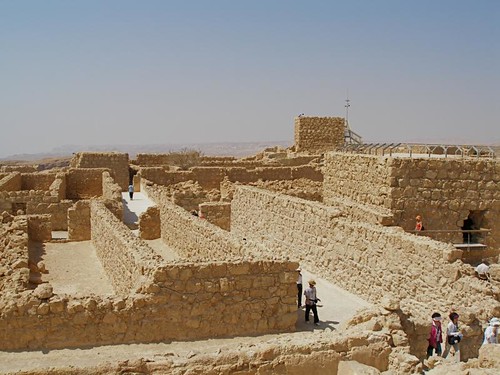This is a request from my Father who recently visited Israel.
Masada, an ancient mountaintop fortress in southeast Israel, is the site of the Jews’ last stand against the Romans after the fall of Jerusalem in AD 70.
Masada occupies the entire top of a great mesa near the southwest coast of the Dead Sea. The boat-shaped mountain towers 1,424 feet or 434 meters above the level of the Dead Sea. It has a summit area of about 18 acres. Some authorities hold that the site was settled at the time of the First Temple (circa 900 BC), but Masada is renowned for the palaces and fortifications of Herod the Great, king of Judadea under the Romans, who ruled from 37 to 34 BC, It is also known for its resistance to the Roman siege in AD 72 through 73.
Although first fortified by the Hasmonean king Alexander Jannaeus who ruled from 103 to 76 BC, Herod was the chief builder of Masada. His constructions included two ornate palaces (one of them on three levels), heavy walls, and aqueducts, which brought water to cisterns holding nearly 200,000 gallons or 750,000 liters. After Herod’s death in 4 BC, Masada was captured by the Romans, but the Jewish Zealots, a sect that staunchly opposed domination by Rome, took it by surprise in AD 66.
Following the fall of Jerusalem, and the destruction of the Temple in AD 70, the Masada garrison—the last remnant of Jewish rule in Palestine—refused to surrender and was besieged by the Roman legion X Fretensis. It took the Roman army almost 15,000, fighting a defending force of less than 1,000, including women and children, almost two years to subdue the fortress. The besiegers built a sloping ramp to attack the stronghold, which fell only after the Romans fired the defenders’ wooden walls. The Zealots, however, preferred death to enslavements, and the conquers found that the defenders, led by Eleazar ben Jair, had taken their own lives (April 15, AD 73). Only seven women and children—who had hidden in a water conduit—survived to tell the tale. Masada was briefly reoccupied by the Jews in the 2nd century AD and was the site of a Byzantine church on the 5th-6th century. Thereafter, it was abandoned until the 20th century, except for a brief interval during the Crusades; the Arabs called the mountain as-Sabaa (The Accursed).
A general survey of the ruins was made by Israeli archeologists in 1955-56, and the entire mountaintop was excavated by Yigael Yadin in 1963-65, assisted by thousands of volunteers from around the world. The descriptions of the Roman-Jewish historian Joesphus, until then the only detailed source of Masada’s history, were found to be extremely accurate; the palaces, storehouses, defense works and Roman camps and siege works were all revealed and cleared. A synagogue and ritual bath discovered there are the earliest yet found in Palestine. Among the most interesting discoveries is fragments of broken pottery inscribed with Hebrew personal names. These may be lots cast by the last defenders to determine who should die first.
In the 20th century Masada has become a symbol of Jewish national heroism, and the difficult ascent is regularly performed by Israeli youth groups. It is now one of Israel’s most popular tourist attractions. Arkia, Israel’s domestic airline, provides regular service to a small airfield on the adjacent Dead Sea plain.
Thanks for listening to another episode of History Podcast. If you enjoyed the show please take the time to fill out the survey at historyonair.com. Also, if you shop amazon.com please remember to start your shopping at the our site. Any purchases made will help support the podcast.
